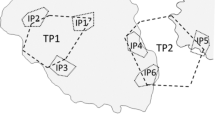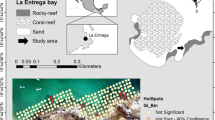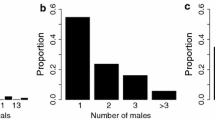Abstract
The ability of larger males to control resources and monopolise spawnings is thought to explain the benefits of protogyny in some animals. Here we describe the breeding and non-breeding social organisations of a temperate protogynous goby, Coryphopterus nicholsii, in the light of this prediction. Our results confirm that C. nicholsii has a stable social organisation, based on the year-round defence of a territory by both females and males. As predicted, larger individuals of both sexes were more likely to defend territories than smaller ones. These territories always included one or more shelter rocks, which were used as refuges by both sexes throughout the year, and also as nest sites by males in the breeding season. We then use experimental manipulation of shelter rock availability to examine the influence of intraspecific competition on territory establishment by smaller males. Following the removal of resident, non-nesting males, territories were quickly taken over. In addition, artificial reefs and nest sites were quickly colonised. Therefore, it appears that suitable shelter rocks are limited. Furthermore, intraspecific competition is strongly size-specific in C. nicholsii and determines which individuals gain access to shelter rocks. The presence of these social conditions is consistent with the prediction that the ability of larger males to monopolise more than one mate affects the occurrence of protogyny in some animals, and may clarify the occurrence of protogyny in C. nicholsii.
Similar content being viewed by others
References cited
Baird, T.A. & N.R. Liley. 1989. The evolutionary significance of harem polygyny in the sand tilefish, Malacanthus plumieri: resource or female defence? Anim. Beh. 38: 817-829.
Breder, C.M. & D.E. Rosen. 1966. Modes of reproduction in fishes, 1st ed. The Natural History Press, New York. 941 pp.
Breitburg, D.L. 1987. Interspecific competition and the abundance of nest sites: factors affecting sexual selection. Ecol. 68: 1844-1855.
Brown, J.L. & G.H. Orians. 1970. Spacing patterns in mobile animals. Ann. Rev. Ecol. Syst. 1: 239-262.
Buchheim, J.R. & M.A. Hixon. 1992. Competition for shelter holes in the coral-reef fish Acanthemblemaria spinosa Metzelaar. J. Exp. Mar. Biol. Ecol. 164: 45-54.
Burley, N. 1986. Sexual selection for aesthetic traits in species with biparental care. Amer. Nat. 127: 415-445.
Cardwell, J.R. 1989. Behavioural endocrinology of the stoplight parrotfish, Sparisoma viride, Scaridae, a protogyhous coral reef fish. Ph.D. Dissertation, University of British Columbia, Vancouver. 127 pp.
Charnov, E.L. 1982. The theory of sex allocation, 1st ed. Princeton University Press, Princeton. 335 pp.
Cole, K.S. 1982a. Male reproductive behaviour and spawning success in a temperate zone goby, Coryphopterus nicholsii. Can. J. Zool. 60: 2309-2316.
Cole, K.S. 1982b. Territoriality and social behaviour in a temperate zone pacific goby, Coryphopterus nicholsii. Ph.D. Dissertation, University of Alberta, Edmonton. 187 pp.
Cole, K.S. 1983. Protogynous hermaphroditism in a temperate zone territorial marine goby, Coryphopterus nicholsii. Copeia 1983: 809-812.
Cole, K.S. 1984. Social spacing in the temperate marine goby Coryphopterus nicholsii. Mar. Biol. 80: 307-314.
Cole, K.S. & D.Y. Shapiro. 1990. Gonad structure and hermaphroditism in the gobiid genus Coryphopterus (Teleostei: Gobiidae). Copeia 1990: 996-1003.
Davies, N.B. 1991. Mating systems. pp. 263-300. In: J.R. Krebs & N.B. Davies (ed.) Behavioural Ecology, an Evolutionary Approach, Blackwell Scientific Publications, Oxford.
Emlen, S.T. & L.W. Oring. 1977. Ecology, sexual selection, and the evolution of mating systems. Science197: 215-223.
Gascon, D. & R.A. Miller. 1981. Colonization by nearshore fish on small artificial reefs in Barkley Sound, British Columbia. Can. J. Zool. 59: 1635-1646.
Ghiselin, M.T. 1969. The evolution of hermaphroditism among animals. Quart Rev Biol 44: 189-208.
Haines, T.A. & R.L. Butler. 1969. Responses of yearling smallmouth bass (Micropterus dolomieui) to artificial shelter in a stream aquarium. J. Fish. Res. Board Can. 26: 21-31.
Hart, J.L. 1973. Pacific fishes of Canada. Bull. Fisheries Research Board of Canada, St. Andrews. 740 pp.
Hoffman, S.G., M.P. Schildhauer & R.R. Warner. 1985. The costs of changing sex and the ontogeny of males under contest competition for mates. Evol. 39: 915-927.
Krebs, J.R. 1971. Territory and breeding density in the great tit, Parus major L. Ecol. 52: 2-22.
Kroon, F.J. 1997. Protogynous hermaphroditism in a temperate reef fish, the blackeye goby, Coryphopterus nicholsii (Pisces: Gobiidae). Ph.D. Dissertation, University of British Columbia. Vancouver. 132 pp.
Larson, R.J. 1980a. Influence of territoriality on adult density in two rockfishes on the genus Sebastes. Mar. Biol. 58: 123-132.
Larson, R.J. 1980b. Territorial behavior of the black and yellow rockfish and gopher rockfish (Scorpaenidae, Sebastes). Mar. Biol. 58: 111-122.
Lejeune, P. 1987. The effect of local stock density on social behavior and sex change in the Mediterranean labrid Coris julis. Env. Biol. Fish. 18: 135-141.
Markell, R.W. 1993. An adaptive value of spatial learning and memory in the blackey goby, Coryphopterus nicholsii. Anim. Beh. 47: 1462-1464.
Miller, P.J. 1984. The tokology of gobioid fishes. pp. 119-153. In: G.W. Potts & R.J. Wootton (ed.) Fish Reproduction: Strategies and Tactics, Academic Press, London.
Nursall, J.R. 1977.Territoriality in redlip blennies (Ophioblennius atlanticus-Pisces: Blenniidae). J. Zool., Lond. 182: 205-223.
Robertson, D.R. 1972. Social control of sex reversal in a coral-reef fish. Science 177: 1007-1009.
Schwarz, A.L. & C. Lavett-Smith. 1990. Sex change in the damselfish Dascyllus reticulatus (Richardson) (Perciformes: Pomacentridae). Bull. Mar. Sci. 46: 790-798.
Southwood, T.R.E. 1966. Ecological methods, 1st ed. Methuen, London. 391 pp.
Steele, M.A. 1996. Effects of predators on reef fishes: separating cage artifacts from effects of predation. J. Exp. Mar. Biol. Ecol. 198: 249-267.
Thresher, R.E. 1984. Reproduction in reef fishes. T.F.H. Publications, Neptune City. 399 pp.
Van Rooij, J.M.E., F.J. Kroon & J.J. Videler. 1996. The social and mating system of the herbivorous reef fish Sparisoma viride: one-male versus multi-male groups. Env. Biol. Fish. 47: 353-378.
Warner, R.R. 1975. The adaptive significance of sequential hermaphroditism in animals. Amer. Nat. 109: 61-82.
Warner, R.R. 1984. Mating behavior and hermaphroditism in coral reef fishes. Amer. Sci. 72: 128-136.
Warner, R.R. 1988. Sex change and the size-advantage model. Tree 3: 133-136.
Warner, R.R. & P. Lejeune. 1985. Sex change limited by paternal care: a test using four Mediterranean labrid fishes, genus Symphodus. Mar. Biol. 87: 89-99.
Warner, R.R., D.R. Robertson & E.G. Leigh, Jr. 1975. Sex change and sexual selection. Science 190: 633-638.
Wiley, J.W. 1973. Life history of the western North American goby, Coryphopterus nicholsii, (Bean). Trans. San Diego Soc. Nat. Hist. 17: 187-208.
Wilkins, H.K.A. & A.A. Myers. 1993. Shelter utilization by Gobius cruentatus and Thorogobius ephippiatus (Teleostei: Gobiidae). J. Fish Biol. 43: 763-773.
Zar, J.H. 1984. Biostatistical analysis. Prentice-Hall, Engelwood Cliffs. 718 pp.
Author information
Authors and Affiliations
Rights and permissions
About this article
Cite this article
Kroon, F.J., de Graaf, M. & Liley, N.R. Social Organisation and Competition for Refuges and Nest Sites in Coryphopterus nicholsii (Gobiidae), a Temperate Protogynous Reef Fish. Environmental Biology of Fishes 57, 401–411 (2000). https://doi.org/10.1023/A:1007600728267
Issue Date:
DOI: https://doi.org/10.1023/A:1007600728267




